Viola Dana
| Viola Dana | |
|---|---|
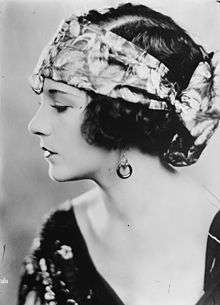 | |
| Born |
Virginia Flugrath June 26, 1897 Brooklyn, New York, U.S. |
| Died |
July 3, 1987 (aged 90) Woodland Hills, Los Angeles, California, U.S. |
| Resting place | Hollywood Forever Cemetery |
| Nationality | American |
| Years active | 1900–1933 |
| Spouse(s) |
John H. Collins (m. 1915; d. 1918) Maurice "Lefty" Flynn (m. 1925; div. 1929) Jimmy Thomson (m. 1930; div. 1945) |
Viola Dana (June 26, 1897 – July 3, 1987) was an American film actress who was successful during the era of silent films. The diminutive actress appeared in over 100 films, but was unable to make the transition to sound films.
Early life
Born Virginia Flugrath on June 26, 1897, she was born and raised in Brooklyn, New York. Dana was the middle sister of three siblings who would all become actresses. Her sisters were known as Edna Flugrath and Shirley Mason. Dana's "upbringing was fairly 'normal', without the poverty and tragedy that marked the early years of so many other young men and women who ultimately turned to the escapist world of the movies."[1]
Dana appeared on the stage at the age of three. She read Shakespeare and particularly identified with the teenage Juliet. She enjoyed a long run at the Hudson Theater in New York City. Between 1910 and 1912, she made four small appearances in the emergent film industry in New York, using the name "Viola Flugrath". A particular favorite of audiences was her performance in David Belasco's Poor Little Rich Girl, when she was 16.
She began performing in vaudeville with Dustin Farnum in The Little Rebel and played a bit part in The Model by Augustus Thomas.[1]
Film career


With the stage name of "Viola Dana", she entered films in 1910, including A Christmas Carol (1910). Her first motion picture was made at a former Manhattan (New York) riding academy on West 61st Street. The stalls had been transformed to dressing rooms. Dana became a star with the Edison Manufacturing Company, working at their studio in the Bronx. She fell in love with Edison director John Hancock Collins and they married in 1915. Dana's success in Collins's Edison features such as Children of Eve (1915) and The Cossack Whip (1916) encouraged producer B. A. Rolfe to offer the couple lucrative contracts with his company, Rolfe Photoplays, which released through Metro Pictures Corporation. Dana and Collins accepted Rolfe's offer in 1916 and made several important films for Rolfe/Metro, notably The Girl Without a Soul and Blue Jeans (both 1917). Rolfe closed his New York-area studio down in the face of the 1918 flu pandemic and sent most of his personnel to California. Dana left before Collins, who was finishing work at the studio; however, Collins contracted influenza which rapidly turned into pneumonia and died in a New York hotel room on October 23, 1918.
Dana remained in California acting for Metro throughout the 1920s, but her popularity gradually waned. One of her last important roles was in Frank Capra's first film for Columbia Pictures, That Certain Thing (1928). She retired from the screen in 1929. Her final screen credits are roles in Two Sisters (1929), One Splendid Hour (1929), and with her sister Leonie Flugrath, better known as Shirley Mason (years earlier she had appeared with her older sister, Edna Flugrath, in the 1923 film The Social Code), The Show of Shows (1929). By the time she made her final film appearance in 1933, she had appeared in over 100 films. She briefly came out of retirement to appear in her first and only television role in a small part on Lux Video Theatre, in 1956.[2]
More than 50 years after her retirement from the screen, Dana appeared in the Kevin Brownlow/David Gill documentary series Hollywood (1980), discussing her career as a silent film star during the 1920s. Footage from the interview was used in the later documentary series Buster Keaton: A Hard Act to Follow (1987) from the same team.[3]
Personal life
Dana's first husband was Edison director John Collins who died in the Influenza epidemic of 1918. In 1920, she began a relationship with Ormer "Lock" Locklear, a daring aviator, military veteran and budding film star. Locklear died when his aircraft crashed on August 2, 1920 during a nighttime film shoot for The Skywayman, for Fox Studios. Although married, Locklear had been dating Dana, and on the night before his death, in a premonition, gave her some of his personal effects. Dana witnessed the 1920 crash and would not fly again for 25 years.[4][N 1]
Locklear was reputed to be the prototype for the character of Waldo Pepper played by Robert Redford in The Great Waldo Pepper (1975). Dana was an honored guest at its premiere.[5]
Dana was married to Yale football star and actor Maurice "Lefty" Flynn in June 1925.[6] They divorced in February 1929.[7] Her third and final marriage was to golfer Jimmy Thomson from 1930 to March 1945.[8] In later years, she volunteered at the Motion Picture & Television Country House and Hospital, before moving there permanently in 1979.[9]In 1990, she was the subject of a documentary short by Anthony Slide, "Vi: Portrait of a Silent Star," in which she talks of her life and career.
Death
Dana died on July 3, 1987 at the Motion Picture & Television Country House and Hospital in Woodland Hills, Los Angeles at the age of 90.[10] Her urn at Hollywood Forever Cemetery lists her as Viola Dana, as well as her real last name Flugrath.
For her contribution to the motion picture industry, Viola Dana has a star on the Hollywood Walk of Fame. It is located at 6541 Hollywood Boulevard.
Filmography
Short subject
- A Christmas Carol (1910)
- Children Who Labor (1912)
- The Butler and the Maid (1912)
- How Father Accomplished His Work (1912)
- The Lord and the Peasant (1912)
- The Third Thanksgiving (1912)
- My Friend from India (1914)
- Molly the Drummer Boy (1914)
- Treasure Trove (1914)
- The Blind Fiddler (1914)
- The Adventure of the Hasty Elopement (1914)
- Seth's Sweetheart (1914)
- Who Goes There? (1914)
- Lena (1915)
- A Thorn Among Roses (1915)
- The Stone Heart (1915)
- The Glory of Clementina (1915)
- A Spiritual Elopement (1915)
- The Portrait in the Attic (1915)
- A Theft in the Dark (1915)
- The Stoning (1915)
- The Slavey Student (1915)
- Her Happiness (1915)
- The Strange Case of Poison Ivy (1933)

Features
- The House of the Lost Court (1915, lost film)
- Cohen's Luck (1915, lost film)
- On Dangerous Paths (1915, lost film)
- Gladiola (1915, lost film)
- Children of Eve (1915)
- The Innocence of Ruth (1916)
- The Flower of No Man's Land (1916, lost film)
- The Light of Happiness (1916, lost film)
- The Gates of Eden (1916, lost film)
- The Cossack Whip (1916)
- Threads of Fate (1917)
- Rosie O'Grady (1917, lost film)
- The Mortal Sin (1917, lost film)
- God's Law and Man's (1917, lost film)
- Lady Barnacle (1917, lost film)
- Aladdin’s Other Lamp (1917, lost film)
- The Girl Without A Soul (1917)
- Blue Jeans (1917)
- The Winding Trail (1918, lost film)
- A Weaver of Dreams (1918, lost film)
- Breakers Ahead (1918, lost film)
- Riders of the Night (1918)
- The Only Road (1918)
- Opportunity (1918)
- Flower of the Dusk (1918, lost film)
- The Gold Cure (1919, lost film)
- Satan Junior (1919)
- The Parisian Tigress (1919, lost film)
- False Evidence (1919)
- Some Bride (1919, lost film)
- The Microbe (1919, lost film)
- Please Get Married (1919, lost film)
- The Willow Tree (1920)
- Dangerous to Men (1920, lost film)
- The Chorus Girl's Romance (1920)
- Blackmail (1920, lost film)
- Cinderella's Twin (1920, lost film)
- The Off-Shore Pirate (1921, lost film)
- Puppets of Fate (1921)
- Home Stuff (1921)
- Life's Darn Funny (1921, lost film)
- The Match-Breaker (1921, lost film)
- There Are No Villains (1921, lost film)
- Fourteenth Lover (1922)
- Glass Houses (1922, lost film)
- Seeing's Believing (1922)
- They Like 'Em Rough (1922, lost film)
- The Five Dollar Baby (1922, lost film)
- June Madness (1922)
- Love in the Dark (1922, lost film)
- Crinoline and Romance (1923, lost film)
- Her Fatal Millions (1923)
- Roughed Lips (1923)
- The Social Code (1923, lost film)
- In Search of a Thrill (1923)
- A Noise in Newboro (1923, lost film)
- The Heart Bandit (1924, lost film)
- Don't Doubt Your Husband (1924, lost film)
- The Beauty Prize (1924, lost film)
- Revelation (1924)
- Merton of the Movies (1924, lost film)
- Open All Night (1924)
- Along Came Ruth (1924, lost film)
- As Man Desires (1924, lost film)
- Forty Winks (1925, lost film)
- The Necessary Evil (1925, lost film)
- Winds of Chance (1925)
- The Great Love (1925, lost film)
- Wild Oats Lane (1926, lost film)
- Bigger Than Barnum's (1926)
- Kosher Kitty Kelly (1926)
- The Ice Flood (1926)
- The Silent Lover (1926)
- Bred in Old Kentucky (1926)
- Home Struck (1927)
- Salvation Jane (1927)
- Naughty Nanette (1927)
- Lure of the Night Club (1927)
- That Certain Thing (1928)
- Two Sisters (1929)
- One Splendid Hour (1929)
- The Show of Shows (1929)
Gallery
 The Flower of No Man's Land (1916)
The Flower of No Man's Land (1916) The Flower of No Man's Land (1916)
The Flower of No Man's Land (1916) The Light of Happiness (1916)
The Light of Happiness (1916)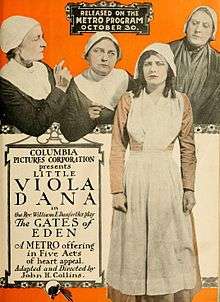 The Gates of Eden (1916)
The Gates of Eden (1916) Threads of Fate (1917)
Threads of Fate (1917)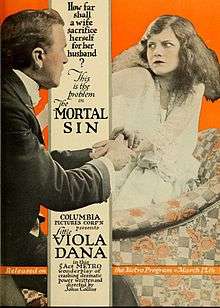 The Mortal Sin (1917)
The Mortal Sin (1917)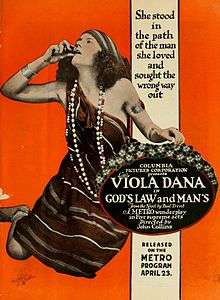 God's Law and Man's (1917)
God's Law and Man's (1917)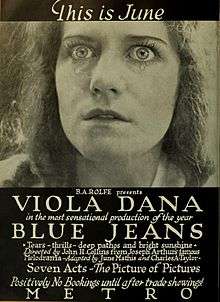 Blue Jeans (1917)
Blue Jeans (1917)_1.jpg) A Weaver of Dreams (1918)
A Weaver of Dreams (1918) The Only Road (1918)
The Only Road (1918) Riders of the Night (1918)
Riders of the Night (1918) Some Bride (1919)
Some Bride (1919)
References
Notes
- ↑ In the "Hazards of the Game" episode of Hollywood (1980), actresses Leatrice Joy and Viola Dana recalled Locklear and the making of his last film. Dana described his final flight.[4]
Citations
- 1 2 Stone, Tammy. "Viola Dana." The Silent Collection. Retrieved: October 22, 2014.
- ↑ Lussier, Tim. "The tragic Flugrath sisters: Hard to believe, But all three experienced the same loss." silentsaregolden.com, 1999. Retrieved: October 22, 2014.
- ↑ "Viola Dana, 1897–1987." Golden Silents, 2014. Retrieved: October 22, 2014.
- 1 2 Farmer 1984, p. 23.
- ↑ Anderson, Nancy. "Viola Dana Loved the Real Waldo Pepper". Greeley Daily Tribune, April 28, 1975, p. 23. Retrieved: October 22, 2014.
- ↑ "Viola Dana Marries Maurice "Lefty" Flynn." The Norwalk Hour, June 22, 1925, p. 5. Retrieved: May 1, 2013.
- ↑ "Viola Dana To Wed Professional Golfer." The Portsmouth Sunday Times, October 11, 1930, p. 2. Retrieved: May 1, 2013.
- ↑ "Divorce Granted Viola Dana." St. Petersburg Times, March 31, 1945, p. 8. Retrieved: May 1, 2013.
- ↑ "Actress Viola Dana, 90, Star of 50 silent movies." Chicago Tribune, July 12, 1987. Retrieved: October 22, 2014.
- ↑ "Silent Movie Star Viola Dana Dies." The Bryan Times, July 11, 1987, p. 3. Retrieved: May 1, 2013.
Bibliography
- Farmer, James H. Celluloid Wings: The Impact of Movies on Aviation. Blue Ridge Summit, Pennsylvania: Tab Books Inc., 1984. ISBN 978-0-83062-374-7.
- "From the Movies to Stardom". Ogden Standard, January 10, 1914, p. 27.
- "Little Viola Dana Ambitious to Become Grown-Up Actress". Indianapolis Star, January 15, 1914, p. 13.
- "Viola Dana In Person at Faurot". Lima News, March 23, 1930, p. 24.
External links
| Wikimedia Commons has media related to Viola Dana. |
- Viola Dana photo gallery
- Viola Dana at the Internet Movie Database
- Viola Dana at the Internet Broadway Database

- Viola Dana at Virtual History